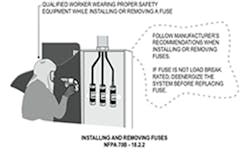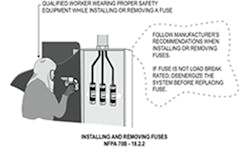Maintenance Procedures for Fuses — Part 2 of 2
Maintenance personnel should implement a maintenance procedure for interval inspections of fuse protected equipment. The maintenance procedure should stress the environmental or operating conditions of a particular installation. The environmental or operating conditions might dictate a specific frequency of maintenance that is different than suggested in NFPA 70B, Recommended Practice for Electrical Equipment Maintenance (Chapter 18 and Annex K and L). It should also be noted that maintenance, inspection, and test methods for fuses that can operate for long periods of time are essentially the same as for electrical equipment.
Part 2 of this two-part series focuses on fuses rated greater than 1,000V. In Part 1 of this two-part series we focused on fuses rated 600V or less.
Fuses greater than 1,000V normally consist of many different parts that are either current carrying or non-current carrying. Such parts can be installed in and subjected to normal or non-normal atmospheric conditions. Fuses can be current-limiting or non-current limiting, sand or liquid filled, or vented expulsion type. The frequency of inspection is important so as to ensure that they are capable of functioning based on the conditions at a given fuse location typically determined by the installer.
Let's review what the current edition of NFPA 70B has to say on this subject.
Power Fuses and Fuseholders
NFPA 70B - Chapter 18
Where appropriately designed fuses in fuseholders are used to protect conductors and equipment, a fuse placed in each ungrounded (phase) conductor will protect conductors and other equipment.
Note: Power fuses of the vented type are not to be used indoors, underground, or in metal enclosures unless identified for such use by the manufacturer.
Utilizing Power Fuses and Fuseholders
NFPA 70B - Chapter 18
Fuses installed in fuseholders are designed to open a circuit under overloads, short-circuits, or ground-fault conditions.
For example, a circuit designed to carry 100A will open and clear the circuit under any of the conditions mentioned. Consider that the amperage of the circuit reached above the 100A limit, it could cause widespread interruption and damage of conductors and equipment. A properly designed weak spot (fuse) is intentionally placed in the circuitry to automatically open the circuit and prevent extensive damage to electrical components.
Note: When properly designed and installed, fuses can be placed so as to cut out the circuit that is in endangered by faulty conditions and permit the rest of the circuit to remain energized where necessary.
Characteristics of Fuses and Fuseholders
NFPA 70B - Chapter 18
WARNING: The interrupting rating of power fuses must not be less than the maximum fault current it is required to interrupt. This includes contributions from other connected sources of energy. Also the maximum voltage rating of power fuses must not be less than the maximum voltage of the circuit.
Note: Fuse mountings and fuse units must be equipped with permanent and legible nameplates showing the manufacturer’s type or designation, continuous current rating, interrupting current rating, and maximum voltage rating, as well as other important information.
This section makes it clear that manufacturers' instructions regarding installing and removing fuses should always be complied with where available. If the fuse does not have a load break rating available then the electrical system should be de-energized before maintenance personnel removes the fuse. This procedure may prevent an accidental arc flash or shock hazardous from occurring.
Inspection and Cleaning of Fuses
NFPA 70B - 18.2.3.1
The fuse should always be disconnected, if possible, and de-energized from electrical power sources before servicing, and an electrically safe work condition per NFPA 70E, Standard for Electrical Safety in the Workplace – Article 120 should then be established. NFPA 70B – Chapter 7 makes such recommendation and references. Insulators should always be inspected for breaks, cracks, and burns. The insulators should be cleaned, particularly where abnormal conditions such as salt deposits, cement related type dust, or acid fumes are present in dangerous amounts, such intervals of maintenance will help prevent flashover conditions. See NFPA 70B - Annexes K and L.
Fuse Surfaces to Inspect and Clean
NFPA 70B -18.2.3.2
Contact surfaces should always be inspected for pitting, burning, alignment, and proper pressure. Contacts that are burned or badly pitted should be replaced, and the following criteria should be complied with:
The fuse unit or fuse tube and renewable element should be examined for corrosion of the fuse element where the conductors are connected.
• Excessive erosion of the inside of the fuse tube should be checked for discharge tracking and dirt on the outside of the fuse tube
• Improper assembly that might prevent proper operation should also be checked
To prevent a hazardous condition, fuse tubes or units showing signs of deterioration should be replaced.
Inspecting Terminals of Fuses
NFPA 70B -18.2.3.3
Items such as bolts, nuts, washers, pins, and terminal connectors should be in place and in a good substantial condition, and for safety, the following criteria should be complied with:
• The lock or latch should be checked.
• Fuse tubes made of organic, such as Class A material, should be re-finished as necessary and comply with the specifications of the manufacturer.
Expulsion Fuses
NFPA 70B -18.2.3.4
Vented expulsion type fuses may be equipped with condensers or mufflers to restrict expulsion of gases during fuse operation. These type fuses may have a dropout feature that automatically disengages during the fuse operation mold. The lower (discharge end) might have a sealing disc over the expulsion chamber that prevents entrance of moisture under certain conditions of use. Vented expulsion fuses might be equipped with condensers or mufflers to restrict expulsion of gases during operation. Such fuses might have a dropout feature that automatically disengages the fuse during operation. Seals should be inspected to ensure that moisture has not entered the interrupting chamber. Seals that show damage or evidence of leakage may be cause for replacing such fuse(s).
Conclusion
Fuses and fuseholders must be designed to permit fuse replacement by qualified maintenance personnel using identified equipment with or without de-energizing the fuseholder as permitted under certain maintenance procedures. Switchboards, panelboards, circuitry, and equipment utilize high-voltage fuses to protect all related components.
Note: NFPA 70B - Annex L recommends that the basic components of fuses have interval inspections at least every 3 years.

